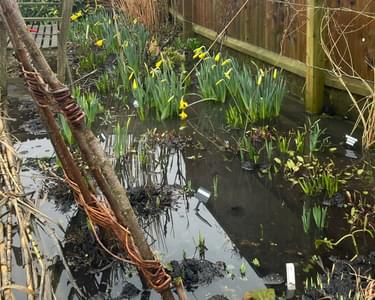What to do if your garden is flooded
We’ve endured seven named storms since September 2023, with prolonged wet weather continuing into 2024. Head gardener Emma O’Neill shares 10 tips for protecting your growing space before and after floodwater.

Waterlogging can stress plants and damage soil. Credit: V Mathisen for Unsplash
Lasting heavy rain or overflow from a local river can result in water standing in your garden for days or weeks, especially if your garden is low-lying. But there are ways to limit the damage.
“Waterlogging can stress plants,” says Emma. “When there’s too much rain in a short amount of time, it fills the pockets of air usually found in the soil that are vital for the nutrients plants need. All this time without nutrients and a good flow of oxygen can be damaging for plants.
“Remember that flooding is usually more of a problem in the summer as plants and microorganisms call for more oxygen – and by following our easy steps, you can limit the damage and allow your growing space to recover.”
How to help your garden recover from floodwater
- Try not to walk on the soil. While it’s sodden, the soil will compact under your feet and push out oxygen needed by plants. If a trip into the garden is unavoidable, lay down boards.
- Help plants recover. It’s vital to encourage the water to drain deeper underground, loosen the soil and reintroduce oxygen. Once the water has receded, fork the ground around shrubs and trees and then layer mulch all over. Worms and microbes will get to work for you, creating air pockets and a healthy texture.
- Save your plants. Sadly, you should not eat any veg that has been covered by flood water. Contaminants, both organic and inorganic, could have been in the water, making your veg potentially unsafe to eat – especially raw salads. “The quickest way to recover and make use of your growing space again is to create raised beds (filling them with peat-free organic compost),” says Emma. “In extreme cases, when a lot of plants need saving, dig a nursery bed. The plants can be rehomed in a mix of soil, compost and grit that will encourage the water to drain."
- Prune damaged plants. “Leaves may be wilting, going yellow or even dropping, and bark might be peeling on trees. If you spot any of these signs, prune any dead branches and give them a helping hand with some organic feed when you see new growth,” says Emma. “Pruning removes any unnecessary foliage which drains the plant’s energy.”
- Make new plants. They may look okay when the waters recede, but many plants can suffer unseen root damage or rot. Take cuttings and you can grow your favourite plants again. In winter, you can take hardwood cuttings of plants such as dogwood, roses and penstemon.

Our pond overflowed into the flower bed in February 2024 after prolonged heavy rain
Planning ahead for next time
- Watch where the water goes. “Keep an eye on where the floodwater is running from and to as this can help you be better prepared for next time,” says Emma. “Choose permeable materials like sustainably-sourced stone, gravel or brick for paths and patios for areas that often flood. This will allow some water to soak in, instead of standing on watertight materials like concrete. You could also incorporate swales or shallow ditches into your garden boundaries, which will guide excess water away.”
- Look after your soil. The best solution for flooding is improving your soil structure. Don’t leave large areas of soil bare. In autumn and spring, use mulches of homemade compost and in the summer and autumn, sow green manures. These methods protect the soil by retaining nutrients and improving absorbency.
- Collect water. Create ponds and living green roofs with sedums and grasses and install plenty of water butts with downpipes from roofs.
- Build a rain garden. These help capture rainwater and are filled with plants that can withstand some waterlogging such as yellow iris, pendulous sedge, arum lily, grasses or shrubs such as Cornus.
- Take action before a flood. “Line vulnerable areas like the base of greenhouses, flower beds or polytunnels with sandbags to direct water away from them,” says Emma. “Arrange buckets on patios and drives before the rain gets too heavy to capture water – which can then be transferred to a water butt.”

Keep off flower and veg beds after flooding